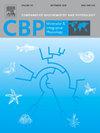夜间短期暴露在昏暗的光线下会影响成年雄性树麻雀的繁殖和代谢相关过程。
IF 2.2
3区 生物学
Q4 BIOCHEMISTRY & MOLECULAR BIOLOGY
Comparative Biochemistry and Physiology A-Molecular & Integrative Physiology
Pub Date : 2025-07-03
DOI:10.1016/j.cbpa.2025.111902
引用次数: 0
摘要
人为因素,特别是城市化,对物种的自然光暗循环有着巨大的影响。本研究探讨了夜间昏暗光照对成年雄性树雀生殖、甾体和代谢基因表达的影响。在当地采集成年雄鸟,分为两组(n = 6只/组)。两组均光照12 h,黑暗12 h,但第二组(dLAN组)在黑暗时间持续昏暗光照(10 lx)。实验进行了2周。之后,采集鸟类样本,收获下丘脑、肝脏和性腺,用于基因表达分析。血浆用于激素和生化检测。研究结果表明,2周的暴露并没有显著改变体重、胆固醇、葡萄糖和睾酮测定。然而,经plana处理的鸟类睾丸体积增加。此外,下丘脑转录物(Tshβ、Dio2、GnRH和Eya3)在季节性生殖过程中的升高,以及睾丸中类固醇转录物(StAr、Scp2、Srd5a1、Hsd11b2和Er)的增加也被观察到;此外,与对照组相比,plan处理组肝脏代谢转录物(Acaca、Fasn、Hmcg、Idh2、Sdhaf4、Sdhaf2、Sdhc、Fh、Mdh、Foxo1、Vip)水平也有所升高。综上所述,本研究表明,即使是短时间暴露在持续2周的较低强度的夜间昏暗光线下,也能刺激树麻雀的下丘脑性腺轴和肝脏代谢。这些结果可能有助于理解夜间光线对昼行性鸟类生理的影响。本文章由计算机程序翻译,如有差异,请以英文原文为准。

Short-term exposure to dim light at night affects reproduction and metabolism-linked processes in adult male tree sparrows (Passer montanus)
Anthropogenic factors, particularly urbanization, have immense implications for the natural light-dark cycle of the species. The present study deliberates on the effects of dim light at night on the transcript expression of reproductive, steroidogenic, and metabolic gene markers in adult male tree sparrows (Passer montanus). Adult male birds were procured locally and were divided into two groups (n = 6 birds/group). Both groups were exposed to 12 h of light and 12 h of darkness, but group two (dLAN group) with a constant dim light (10 lx) during the dark hours. The experiment was run for 2 weeks. After that, birds were sampled, and the hypothalamus, liver, and gonads were harvested and used for gene expression analysis. Blood plasma was used for hormonal and biochemical assays. The findings suggest that 2 weeks of exposure did not significantly change the body mass, cholesterol, glucose, and testosterone assay. However, an increase in testicular volume was observed in dLAN-treated birds. Furthermore, elevation in hypothalamic transcripts (Tshβ, Dio2, GnRH, and Eya3) involved in the seasonal reproduction, along with an increase in steroidogenic transcripts (StAr, Scp2, Srd5a1, Hsd11b2, and Er) in the testis was observed; besides, liver metabolic transcript levels (Acaca, Fasn, Hmcg, Idh2, Sdhaf4, Sdhaf2, Sdhc, Fh, Mdh, Foxo1, and Vip) were also elevated in the dLAN-treated group compared to the control group. Overall, the study shows that even a short-term exposure to the lower intensity of dim light at night of 2 weeks of duration can stimulate the hypothalamic gonadal axis and liver metabolism in tree sparrows. These results could play a role in understanding the effect of light at night on the physiology of diurnal avian species.
求助全文
通过发布文献求助,成功后即可免费获取论文全文。
去求助
来源期刊
CiteScore
5.00
自引率
4.30%
发文量
155
审稿时长
3 months
期刊介绍:
Part A: Molecular & Integrative Physiology of Comparative Biochemistry and Physiology. This journal covers molecular, cellular, integrative, and ecological physiology. Topics include bioenergetics, circulation, development, excretion, ion regulation, endocrinology, neurobiology, nutrition, respiration, and thermal biology. Study on regulatory mechanisms at any level of organization such as signal transduction and cellular interaction and control of behavior are also published.

 求助内容:
求助内容: 应助结果提醒方式:
应助结果提醒方式:


